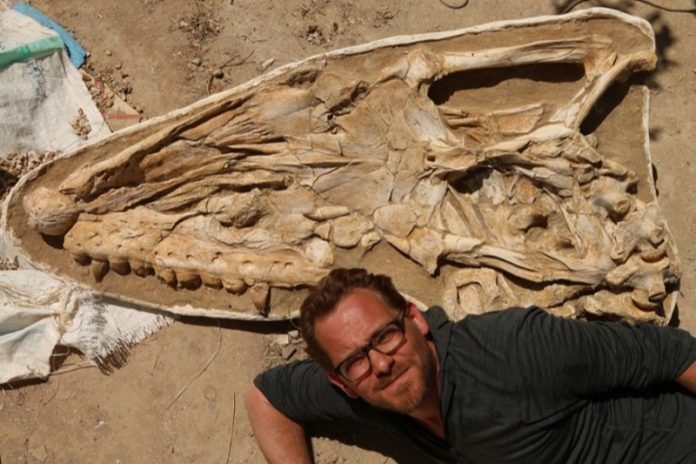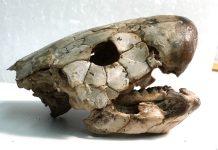
Researchers have discovered a huge new mosasaur from Morocco, named Thalassotitan atrox, which filled the apex predator niche.
With massive jaws and teeth like those of killer whales, Thalassotitan hunted other marine reptiles— plesiosaurs, sea turtles, and other mosasaurs.
At the end of the Cretaceous period, 66 million years ago, sea monsters really existed. While dinosaurs flourished on land, the seas were ruled by the mosasaurs, giant marine reptiles.
Mosasaurs weren’t dinosaurs, but enormous marine lizards growing up to 12 metres (40 feet) in length. They were distant relatives of modern iguanas and monitor lizards.
Mosasaurs looked like a Komodo dragon with flippers instead of legs, and a shark-like tail fin. Mosasaurs became larger and more specialised in the last 25 million years of the Cretaceous, taking niches once filled by marine reptiles like plesiosaurs and ichthyosaurs.
Some evolved to eat small prey like fish and squid. Others crushed ammonites and clams. The new mosasaur, named Thalassotitan atrox, evolved to prey on all the other marine reptiles.
The remains of the new species were dug up in Morocco, about an hour outside Casablanca. Here, near the end of the Cretaceous, the Atlantic flooded northern Africa. Nutrient rich waters upwelling from the depths fed blooms of plankton.
Those fed small fish, feeding larger fish, which fed mosasaurs and plesiosaurs – and so on, with these marine reptiles becoming food for the giant, carnivorous Thalassotitan.
Thalassotitan, had an enormous skull measuring 1.4 metres (5 feet long), and grew to nearly 30 feet (9 metres) long, the size of a killer whale. While most mosasaurs had long jaws and slender teeth for catching fish, Thalassotitan had a short, wide muzzle and massive, conical teeth like those of an orca.
These let it seize and rip apart huge prey. These adaptations suggest Thalassotitan was an apex predator, sitting at the top of the food chain. The giant mosasaur occupied the same ecological niche as today’s killer whales and great white sharks.
Thalassotitan’s teeth are often broken and worn, however eating fish wouldn’t have produced this sort of tooth wear.
Instead, this suggests that the giant mosasaur attacked other marine reptiles, chipping, breaking, and grinding its teeth as it bit into their bones and tore them apart. Some teeth are so heavily damaged they have been almost ground down to the root.
Fossilised remains of prey
Remarkably, possible remains of Thalassotitan’s victims have been discovered. Fossils from the same beds show damage from acids, with teeth and bone eaten away.
Fossils with this peculiar damage include large predatory fish, a sea turtle, a half-meter long plesiosaur head, and jaws and skulls of at least three different mosasaur species. They would have been digested in Thalassotitan’s stomach before it spat out their bones.
“It’s circumstantial evidence,” said Dr Nick Longrich, Senior Lecturer from the Milner Centre for Evolution at the University of Bath and lead author on the study, published in Cretaceous Research.
“We can’t say for certain which species of animal ate all these other mosasaurs. But we have the bones of marine reptiles killed and eaten by a large predator.
“And in the same location, we find Thalassotitan, a species that fits the profile of the killer – it’s a mosasaur specialised to prey on other marine reptiles. That’s probably not a coincidence.”
Thalassotitan was a threat to everything in the oceans – including other Thalassotitan. The huge mosasaurs bear injuries sustained in violent combat with other mosasaurs, with injuries to their face and jaws sustained in fights.
Other mosasaurs show similar injuries, but in Thalassotitan these wounds were exceptionally common, suggesting frequent, intense fights over feeding grounds or mates.
“Thalassotitan was an amazing, terrifying animal,” said Dr Nick Longrich, who led the study. “Imagine a Komodo Dragon crossed with a great white shark crossed with a T. rex crossed with a killer whale.”
The new mosasaur lived in the final million years of the Age of Dinosaurs, a contemporary of animals like T. rex and Triceratops. Along with recent discoveries of mosasaurs from Morocco, it suggests that mosasaurs weren’t in decline before the asteroid impact that drove the Cretaceous mass extinction. Instead, they flourished.
Professor Nour-Eddine Jalil, a co-author on the paper from the Museum of Natural History in Paris, said: “The phosphate fossils of Morocco offer an unparalleled window on the paleobiodiversity at the end of Cretaceous.
“They tell us how life was rich and diversified just before the end of the ‘dinosaur era’, where animals had to specialise to have a place in their ecosystems. Thalassotitan completes the picture by taking on the role of the megapredator at the top of the food chain.”
“There’s so much more to be done,” said Longrich. “Morocco has one of the richest and most diverse marine faunas known from the Cretaceous. We’re just getting started understanding the diversity and the biology of the mosasaurs.”



